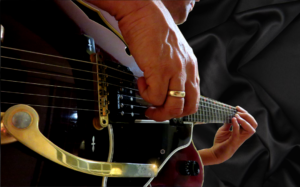Guitar maintenance for performance and protection is an essential part of playing the guitar. The best way to care for your guitar is to simply keep it clean. Dust, dirt, skin oil, sweat, and grease can age your guitar prematurely, negatively impacting its performance.
While cleaning a guitar may sound easy, they are fragile pieces of equipment and must be handled with precision and care. Knowing how to clean your guitar properly without damaging its finish will make it last a very long time. Without regular cleaning, your guitar won’t sound its best – so if you’re not hearing the perfect sound you used to get in your guitar, it may be trying to tell you that it’s time for cleaning!
Why is it important to keep your guitar clean?
Over time, your guitar will get dirty and grime will build up. This affects how the strings vibrate and the sound of your guitar. This is something that occurs naturally but there are also other things that can get your guitar dirty (more on that below!).
If dirt, dust, oil or any other substance builds up on your guitar – whether it’s on the strings, fretboard, or body – it will affect the quality of the sound when playing it. You won’t hear your guitar’s true sound and a dirty guitar will sound…dirty. Cleaning your guitar on a regular basis will also help the strings last longer.
The dirt can also scratch the finish of the guitar. If you play your guitar when there is dirt on it, even soft touches can cause tiny scratches which can grow over time. If this scratching continues, it may cause your guitar’s finish to erode. A regularly cleaned guitar will prevent damage and make it last much longer.
How can a guitar get dirty?
Dust, the dirt underneath fingernails or natural oils produced by our skin are just a few of the things that can get a guitar dirty. The more you play your guitar, the dirtier it will become. If you hear any unusual sounds coming from your guitar it is probably time to clean it.
Where you store your guitar has a lot to do with how clean it’s going to stay when you’re not playing it. If you’re not keeping your guitar in a case, you should definitely invest in a good quality one. Although a hard case is often recommended, it can be expensive and difficult to carry around. A durable, thick and padded soft case will prevent your guitar from not only building up dirt when you’re not playing it, but also reduce the chance of damaging it when traveling.
Although cases help immensely in maintaining the quality of your guitar, regular use typically results in a guitar becoming dirty.
How to clean your guitar
First and foremost, you will need a few items to start cleaning your guitar. You will need:
- soft cloths (lint-free)
- a soft brush
- guitar polish (if you have a satin finish guitar)
- lemon oil (read more about lemon oil here)
Before you begin cleaning, place your guitar on a firm surface such as a table and place something soft underneath it so that it doesn’t get scratched – a towel will do the trick. Rest your guitar’s neck on a neck holder, or a solid surface that won’t damage it.
Start cleaning your guitar by unstringing the guitar. This is the perfect time to clean a guitar as you’ll be able to thoroughly clean all the parts of the guitar. You can also coordinate a time to both clean your guitar and change the strings. This will help you get two things done at once and it’s a good excuse to clean your guitar!
Step 1: Unstring Your Guitar
Rotate the tuning heads backward to unstring your guitar. Once the strings are loose, you can remove the pins for each string from the bridge and pull them out. After unstringing your guitar, make sure to put your bridge pins somewhere safe so you don’t lose them.
Step 2: Dust Your Guitar
Use a soft brush to dust all the parts of your guitar – especially the tuning heads and the bridge pins. Start dusting from bottom to top or vice versa, whichever you’re comfortable with. Dusting your guitar will help you clean it and prevent any additional dirt from forming when cleaning it.
Take one of the microfiber cloths to get rid of the rest of the dust on the body and neck of the guitar. Next, dust the back of the guitar. A microfiber cleaning cloth is the best, but you can also use an old shirt that is 100 percent cotton (just be certain that it’s lint-free). Use a pencil beneath the soft cloth or your finger to dust the parts of your guitar and get the dirt where you can’t reach.
Step 3: Clean Your Guitar
Start from the head of the guitar and gradually work your way down to the body. You want to start cleaning the dirtiest parts of your guitar first, then the cleaner areas which is oftentimes the body of the guitar.
Spray a little bit of lemon oil on the cloth and gently wipe down the head of your guitar. Use circular motions but don’t apply too much pressure on the guitar. Apply lemon oil as needed and pressure when necessary.
Step 4: Clean The Tuning Keys
Wipe the tuning keys very carefully as they are very delicate and can break easily. If the tuning keys are dirty, you can get some lemon oil on the cloth to get rid of the grease.
Regardless of which part of the guitar you’re cleaning, always use a little bit of lemon oil or guitar cleaner and apply more as needed. You don’t want to use too much guitar cleaner as the chemicals in it can hurt the paint when used excessively. As for what kind of guitar cleaner to choose, use a commercial guitar cleaner that is suitable for your guitar’s finish (you can review a comparison of some popular guitar cleaning kits at this link).
Step 5: Clean The Fretboard
When cleaning the fretboard, you can put the pencil beneath the cloth again, or use another sharp tool. Any sharp tool that doesn’t stick out from the cloth and possibly damage your frets is perfectly fine. Gently clean each fret. Start at the base or top of the frets to clean the dirt that builds up at the edge of the frets. Move up and down and do this for each fret. You will see the dirt coming out of your guitar if you haven’t cleaned it for some time.
Step 6: Clean The Body And Bridge
You can now start to clean the body and the bridge of the guitar. Make sure to treat the bridge of the guitar with extra care. It’s one of the most important and fragile parts of your guitar.
Once again, use circular motions without putting too much pressure and let your guitar absorb the lemon oil. If there is any excess oil left, wipe it off. Don’t forget to clean the back of your guitar as well.
After cleaning the bridge of your guitar, see if there is any damage to it. The best way to locate damages to the bridge of a guitar is by trying to insert a piece of paper underneath the bridge. If you can get in underneath the bridge – even a tiny bit in the corners – this is an early warning sign. It indicates that it may be about to break down soon. Take your guitar to a repair shop and let a luthier (people who fix and build guitars) who can repair it for you.
Step 7: Polish Your Guitar
Polishing your guitar will make small scratches disappear and will also shine the guitar. Make sure to use very little polish (see the instructions on the kind of guitar polish you’re using) and distribute to polish evenly across your guitar. Don’t leave polish residue on the guitar once you’re done as it can wear away the color of your guitar.
Step 8: Restring Your Guitar
Once your guitar is cleaned and polished, you can put new strings or clean the ones you removed and put them on. Ideally, you will need a string cleaner to clean the strings, but you can use a microfiber cloth that will pick up dust or dirt on the strings.
Finally, carry out final checks to see if any area of your guitar is still dirty or looks oily. It’s best to go over the guitar a few times with the dry side of the cloth so that there isn’t any excess oil left.
How to keep a guitar clean
Prevent your guitar from getting dirty by washing your hands before playing it and applying a tiny bit of hand sanitizer on your hands. The hand sanitizer will give you smoother hands that are free from harmful oils which can damage the strings. Just make sure to rub your hands together, and play when the hand sanitizer is completely dried off. The alcohol in the hand sanitizer can affect the vibration of the string, creating a squeaky sound, even hours after applying it to your hands. It’s best to not touch your guitar until the hand sanitizer is completely dried off.
After each session of playing, wipe your guitar with a cloth to extend the life of the strings and put it in its case. If you leave your guitar out in the open, the dust in your home can stick to it and build up dirt quickly.
As long as you keep your hands and guitar clean, the only time necessary for cleaning should be when you change the strings.
Caring for your guitar is an essential part of owning one. A clean guitar will always sound clean and stay true to its sound.

